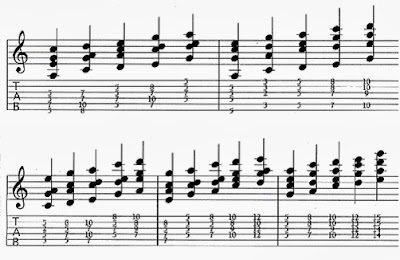11-Note Pentatonic Kalimba
For our purposes, let's examine the A minor pentatonic scale (A-C-D-E-G). Many of us first encountered this scale in a rock or blues context; it has many other potential applications! First, let's harmonize the scale in 3-note voicing:
Here are some playable
4-note voicing.
For example, the 2nd voicing shown could be used as:
F6/9, Am7sus4, Dm7sus4, Bbmaj13, C6/9, F#7alt, Gm9sus4, and a few other things!
|
|
A
|
C
|
D
|
E
|
G
|
|
Am
|
root
|
3rd
|
4th (11th)
|
5th
|
7th
|
|
C, C7, C9,etc.
|
6th (13th)
|
root
|
2nd (9th)
|
3rd
|
5th
|
|
Gm
|
2nd (9th)
|
4th (11th)
|
5th
|
6th
|
root
|
|
Dm
|
5th
|
7th
|
root
|
2nd (9th)
|
4th (11th)
|
|
D7sus4
|
5th
|
7th
|
root
|
2nd (9th)
|
4th (11th)
|
|
F
|
3rd
|
5th
|
6th
|
7th
|
2nd (9th)
|
|
Bb
|
7th
|
2nd (9th)
|
3rd
|
#11
|
6th
|
|
F#7alt
|
#9th
|
b5th
|
#5th
|
7th
|
b9th
|
There are others, but this will do for now.
Of course, it'd be pretty tough to memorize this table, so here are a few hints.
You can use this pentatonic scale harmonically just as you might use it melodically:
A Few Hints:
• On a minor chord, you can use a minor pentatonic scale starting from the chord's root, 2nd, or 5th.
• On a major chord, you can use a minor pentatonic scale starting from the chord's 3rd, 6th (or 7th for a Lydian [#11] sound).
• On an unaltered dominant 7th chord or 7sus4, you can use a minor pentatonic scale starting from the chord's 2nd, 5th or 6th.
• On an altered dominant 7th, you can use a minor pentatonic scale starting from the chord's #9.
Okay, let's look at some musical examples now.
In the first couple of examples, we'll continue to use the A minor pentatonic over a set of changes.
Then we'll get into mixing and matching different minor pentatonics using the guidelines above.
In example 1, we have a common ii-V7-I progression, all handled with the A minor pentatonic scale.
Example 2 is a I-IV-iii-VI progression in F major. Note
the #11 sound on the IV. Again,
we're using only voicing from A minor pentatonic.
I've labeled the scale choices; check them against the "hints" above to see how I chose the scales.
In example 4, I used Dm, Em and Am pentatonic to play over a long stretch of D minor.
(This example's not too interesting rhythmically; I wanted to cram in a lot of voicings!)
Try voicing like this next time you play "Impressions" or "So What".







Love your blog! I can't wait to play with some pentatonic scale harmonies when I get home from work.
ReplyDeleteGlad you liked it, thank you.
Delete